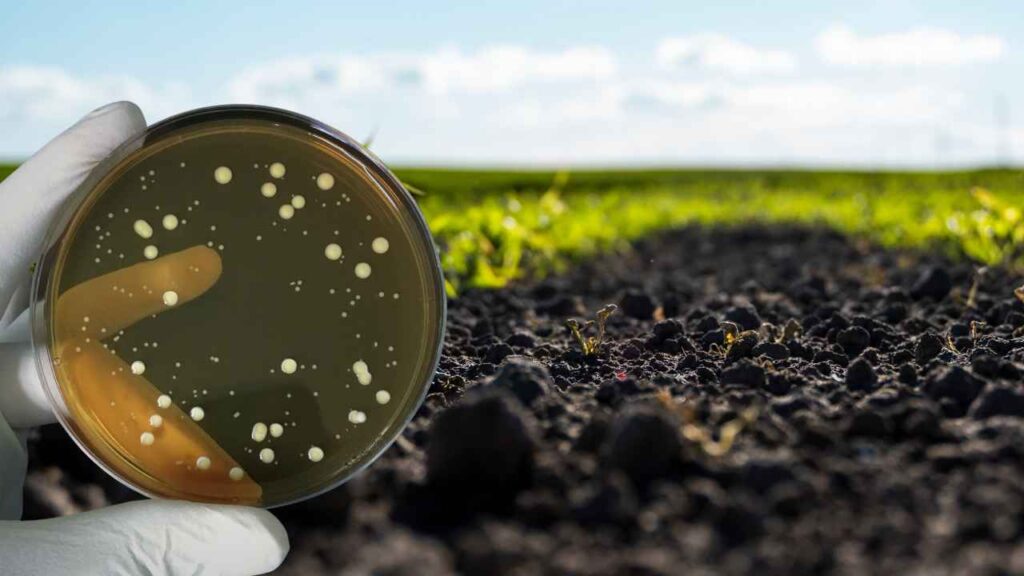Soil microorganisms are invisible allies in the fight against climate change through carbon sequestration
Did you know that soil microorganisms play a crucial role in mitigating climate change? There is a lot of talk about how plants store CO₂, but have you ever wondered how soil microorganisms contribute to this process?
They are key to transforming organic matter and helping to keep carbon on the soil. With that mechanism, they help balance carbon fluxes and are important allies in combating climate change and building a more sustainable agriculture. Let’s understand better about this topic.
What Are Soil Microorganisms?
Soil microorganisms are microscopic organisms that are part of the terrestrial biome. In each gram of soil, there can be from 10 million to 1 billion organisms, with high diversity and specific functions. This biodiversity ensures that important functions for the soil are maintained, even in adverse conditions.
There are different types of microorganisms in the soil, such as bacteria, fungi, and archaea. Bacteria are unicellular and have a great capacity for adaptation, being essential for the decomposition of organic matter and nutrient cycling.
Fungi, in turn, are multicellular organisms that form structures such as mycelia and mushrooms, acting in the decomposition of more complex plant residues.
Archaea, on the other hand, are considered more primitive organisms, adapted to extreme environments, and also participate in the decomposition and transformation of organic matter.
The Importance of Soil Microorganisms for Carbon Sequestration
Soil microorganisms play a central role in the decomposition of organic matter and the stabilization of carbon in the soil. To do this, they develop different strategies that are essential to accomplish these processes. These activities make them indispensable allies in tackling climate change and promoting more resilient agricultural systems.
R and K Strategies: How Microorganisms Act in Soil
Microorganisms can be classified as r or K strategists, depending on how they use available resources.
R strategists are those who use materials that are easy to decompose, such as fresh organic waste rich in labile carbon. These microorganisms grow rapidly, but their population also declines rapidly when resources are depleted.
K strategists, on the other hand, are microorganisms that use resources more slowly and efficiently, taking advantage of more complex and resistant compounds, such as stable organic matter. They are key to keeping carbon stored in the soil for long periods.
However, the dynamics of resource use in the soil can be influenced by several factors. One of them is the addition of fresh organic matter, which leads to the phenomenon known as the priming effect.
What is the Priming Effect?
The priming effect is a phenomenon that occurs in the soil when there is the addition of fresh organic matter. Soil microorganisms tend to use carbon sources according to their availability.
When an easily degradable source is added, the microorganisms temporarily reduce the decomposition of the more stable organic matter in the soil and focus on this new material.
However, after the rapid consumption of easily degradable matter, some microorganisms that survived start to use soil organic matter again.
This return to decomposition of stable composts is known as positive priming and can result in both increased and stabilized carbon in the soil.
The Importance of Soil Microorganisms for Carbon Sequestration
Soil microorganisms are responsible for the carbon cycle, an essential process for carbon sequestration. When organic waste falls into the soil, it goes through the process of decomposition, which transforms organic carbon into more stable and less volatile forms.
During decomposition, microorganisms transform complex organic compounds into smaller molecules, which can be incorporated into the soil or released as gases.
How Does Soil Carbon Sequestration Work?
Carbon sequestration happens when atmospheric CO2 is captured and stored in soil organic matter. Soil microorganisms perform the decomposition and transformation of waste, promoting the incorporation of carbon in a stable way.
In addition, some microbiological processes, such as the formation of humic substances, help stabilize carbon in the soil for long periods.
The presence of microorganisms that are efficient in decomposition, such as certain fungi and bacteria, ensures that carbon is immobilized efficiently.
How to Measure Carbon Sequestration in the Soil?
Soil carbon quantification can be accomplished in a variety of ways, depending on the complexity of the methods and the resources available. A simplified way is to use the equation: Ec = Soil Density x Carbon Content x Depth, ideal for quick estimates.
In addition, the use of modeling has become an efficient practice to assess soil carbon stock, especially in large areas. According to a recent study, mathematical models allow you to calculate carbon sequestration with greater accuracy and efficiency.
The use of biological indicators, such as microbial biomass and enzyme activity, also helps to estimate the amount of carbon stored in the soil.
In addition, laboratory analyses that quantify total organic carbon are widely used, complementing mathematical models and ensuring greater veracity in the estimate.
___
KNOW MORE!
Sustainable Practices for Soil Carbon Sequestration
Investing in sustainable agricultural practices is key to maintaining the carbon balance in the soil. The use of cover crops and integrated systems are strategies that promote the increase of organic matter and strengthen the action of microorganisms.
Ensuring soil biodiversity is essential to help mitigate climate change. Maintaining sustainable practices and promoting proper soil management are key steps in achieving these goals.
Referências:
Andreote, F. D., & Cardoso, E. J. B. N. (2016). Introdução à biologia do solo. In Microbiologia do solo (p. 221 il). Piracicaba: ESALQ. https://doi.org/10.11606/9788586481567
Béghin-Tanneau, R., Guérin, F., Guiresse, M., Kleiber, D., & Scheiner, J. D. (2019). Carbon sequestration in soil amended with anaerobic digested matter. Soil and Tillage Research, 192, 87-94. https://doi.org/10.1016/j.still.2019.04.024
Gonçalves, D. R. P., Inagaki, T. M., Barioni, L. G., Junior, N. L. S., Cherubin, M. R., de Moraes Sá, J. C., … & Anselmi, A. (2024). Accessing and modelling soil organic carbon stocks in Prairies, Savannas, and forests. Catena, 243, 108219. https://doi.org/10.1016/j.catena.2024.108219
By: Mariana Pezzatte Pollo, CCARBON/USP
How to cite this article:
POLLO, M. P. The Power of Soil Microorganisms in Carbon Sequestration. CCARBON/USP, 2025. Available at: <LINK>. Accessed on: DATE





